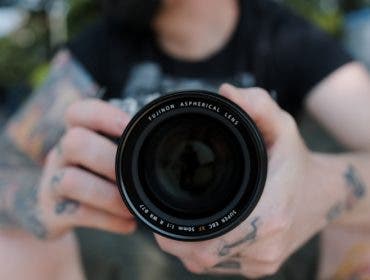Photographers rely on specific camera lens types to create a distinct visual style that suits their workflow. Prime lenses have a few qualities that put them at the top of many gear lists. This quick guide will get you up to speed on primes and all of their ins and outs.
What Is a Prime Lens?
Prime lenses have fixed focal lengths, which means they can’t zoom. They also have a reputation for superior sharpness, lighter weight, and higher overall image quality than their zoom-equipped counterparts. As the technology advances, the gap in quality is narrowing, but there are certain features native to prime lenses that make them the perfect choice for many photogs.

Benefits of Prime Lenses
Wide Aperture
Primes can open up as wide as f/0.95, allowing for a shallow depth of field that separates a subject from the background and introduces pleasing blur. Wide apertures also let in more light, and they allow photographers to work more easily in dim environments.
Fast Shutter Speed
A wider aperture results in faster shutter speeds. In practical terms, this lets you freeze motion, even in low light. It also cuts down the amount of camera shake-related blur.
Light Weight (in general)
Because prime lenses have fewer internal components than zoom lenses, they tend to be lighter in the backpack. That’s a great perk for long shooting days or when you’re hiking long distances while carrying lots of gear. While some primes are built like brick houses, those more robust versions are rarer than their lighter counterparts.
Price
Prime lenses have a lower average price point than their zooming brethren. That means budget-savvy photographers can get their hands on fast glass without dinging their bank accounts.
Sharpness
Many shooters tend to think prime lenses are sharper than zoom lenses, and while that may have been true in the past, the gap is rapidly narrowing. Zoom lenses are often sharper in the middle of their focal range, but primes tend to be sharper wide-open. So, if an ultra-blurry background and a tack sharp subject are your ideal, a prime lens with a wide maximum aperture (such as 1.8 and below) could be your best bet.
While these benefits may make it sound like choosing a prime lens is a no-brainer, keep a few caveats in mind. Primes are less versatile than zooms as they require photographers to reframe a shot by moving their body rather than by zooming. And if you want to shoot multiple focal lengths, you’ll need multiple lenses, which can mean more weight to carry and more time for lens changes.

Ideal Focal Lengths for Genre and Style
It’s important to know which focal length works best for your genre and personal style before investing in a lens.
Ultra-wide
Below 24mm, ultra-wide angle prime lenses capture wide fields of view. They’re used by architectural, landscape, environmental portrait, and event photographers who need to capture large groups or people in very small spaces. They have significant distortion, so take that into account before you buy.
Wide-Normal
Comprising the area between 24mm and 50mm, wide-to-normal angle lenses capture a field of view similar to the human eye. They’re arguably the most versatile lenses and are used by photographers across the board, including street, fashion, landscape, portrait, and wedding photogs.
Long to Telephoto
At 70mm and above, telephoto and long lenses are generally favored by portrait, beauty, wildlife, and sports photographers. They’re known for compression and let you capture subjects at greater distance. They’re also prone to camera shake and are generally heavier than shorter lenses.
Conclusion
Whatever style of photography you prefer, prime lenses will give photographers clean images with good separation and the ability to work in low light across all genres. Those qualities alone make them a worthwhile investment for most shooters.
If you’re looking for a reliable lens to suit your style, don’t miss out on Adorama’s wide selection of all lens types for any budget. We carry lenses built for all your favorite camera brands, including Canon, Sony, Nikon, and many others.
Feature photo by Silvana Carlos on Unsplash






